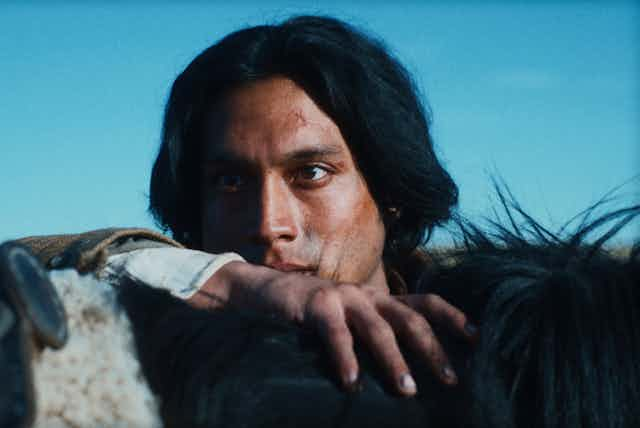How can filmmakers depict genocidal violence in ways that audiences can both comprehend and bear to watch? Bar the extensive and still-growing number of films about the Holocaust (with recent releases including One Life, The Zone of Interest and Occupied City), mainstream cinema has found this challenge daunting.
The challenge only becomes more urgent as contemporary awareness of the enormity of the murderous ethnic cleansing that underpinned European colonialism grows. Such “unmasterable pasts” remain charged and contested political terrain within national mythologies of origin and nation building.
As director Felipe Gálvez Haberle’s ambitious and disturbing debut film, The Settlers, reminds us, movies have themselves often played a crucial role in helping establish and disseminate such mythologies.
The early 1970s cycle of “Vietnam westerns” such as Little Big Man (1970) and Soldier Blue (1970), challenged these mythologies and inverted the frontier narratives of the classic Hollywood western. These movies placed Native Americans, the principal victims of “manifest destiny” (the idea that white Americans had a divine right to settle the continent), at their centre and presented US cavalrymen as mass murderers. For counterculture youth audiences, the analogy between historical settler violence and contemporary US aggression overseas was unmistakable.
The Settlers
There are echoes of the western in The Settlers. The film depicts, with unremitting grimness, the genocide of the indigenous Selk’nam people of Tierra del Fuego, Patagonia, at the turn of the 20th century. The Spanish landowning elite commissioned the violence, with the collusion of the nascent Chilean state. They saw the native population merely as a hindrance to their sheep-rearing empires.
Spectacular shots of the three horsemen dispatched on this bloody mission, led by Scottish ex-army man and self-styled “Lieutenant” McClellan (Mark Stanley), call to mind countless cinematic odysseys as they travel across the prairies and peaks of the American west. Simone d’Arcangelo’s impressive cinematography avoids pictorialism, rendering the archipelago’s awesome, savagely beautiful grasslands and mountains in muted, sombre hues.
The characters traversing Monument Valley in Wagonmaster (1950) or The Searchers (1955) were themselves raised to epic stature by their sublime surroundings. Whereas the protagonists of The Settlers seem to contaminate their pristine environment with their moral squalor. This is underlined by including the veteran “Indian fighter” Bill (Benjamin Westfall) in the party. His unrelenting, vicious white supremacy borders on caricature.
McClennan’s “thin red line” trooper’s tunic signposts another revision of the western genre. It recalls the upstanding imperialist chaps of old-school cinematic colonial fantasies, like Stanley Baker in Zulu (1964) or Michael Caine in The Man Who Would Be King (1975). Unlike them, however, the corrupt, ruthless McClennan is as debased and degraded as his uniform is tattered and stained. He is as murderous and brutal as his local, anything but fond, nickname “The Red Pig” suggests.
A surreal, violent encounter with another ragged British cast-off, the deranged Colonel Martin (Sam Spruell), only confirms the film’s depiction of the entire imperialist “mission” as irredeemably depraved.
Horror and complicity
Felipe Gálvez Haberle already has a challenge on his hands, persuading audiences to endure his film’s unbroken succession of killings accompanied by, in one almost unwatchable sequence, sexual violence. But it’s exacerbated further by the perhaps questionable decision to place the dramatic focus almost entirely on the perpetrators, rather than the victims.
Bar a single cutaway shot revealing a group immediately before their slaughter and a small, though significant, female speaking part, the indigenous Salk’nam are barely seen other than as bloodied corpses. The closest to an empathic character is the increasingly appalled, yet inescapably complicit, mestizo sharp-shooter Segundo (Camilo Arancibia), who completes the roving trio.

It becomes clear how crucial Segundo’s spectatorship is to the film in the daring and unexpected final act. Here the film leaps forward seven years. It moves straight from the primal, violent scenes on the pampas to the hushed refinement of a palatial townhouse. A tense meeting ensues between a semi-retired and eminent rancher named Menéndez (Alfredo Castro) and an urbane Chilean government official (Marcelo Alonso). The official is ostensibly investigating the now embarrassing bloody excesses of the recent past.
The trail leads him back to Segundo, the expedition’s sole survivor, nursing his traumatic memories and guilt in an isolated hut at the ocean’s edge.
Unsurprisingly, the government’s real agenda is to whitewash, rather than redress, Menendez’s scandalous but hugely profitable crimes and to reincorporate indigenous trauma into the national narrative. This is symbolically accomplished in the film’s unsettling final moments. Segundo and his Selk’nam wife Kiepja (Mishell Guaňa) are made to dress in European costumes and drink tea, for the benefit of the official’s movie crew.
Kiepja’s gazes resistantly back at the camera. Her expression shows her refusal to consent to the charade of a happy Europeanised nation, challenging the crew’s attempt to create propaganda. But it also invites our own reflection on the role movies, images and ideology have played, and continue to play, in framing and repressing traumatic memory.

Looking for something good? Cut through the noise with a carefully curated selection of the latest releases, live events and exhibitions, straight to your inbox every fortnight, on Fridays. Sign up here.

